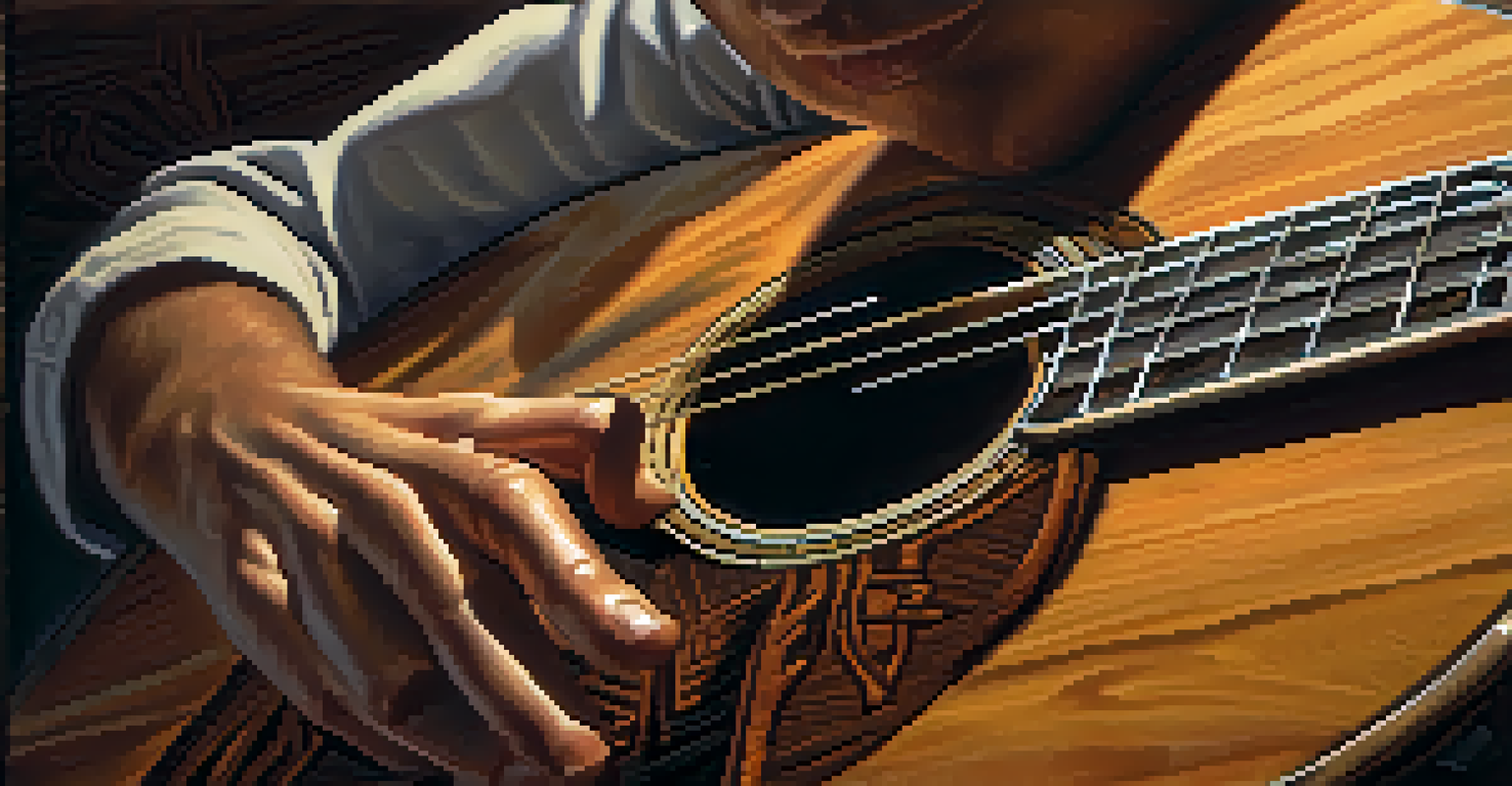The Role of Dynamics in Guitar Song Structure Analysis

What Are Dynamics in Music and Guitar Playing?
Dynamics in music refer to the varying levels of volume and intensity during a performance. In the context of guitar playing, this can mean everything from soft, gentle strumming to powerful, aggressive riffs. The use of dynamics adds emotional depth and texture to a piece, making it more engaging for the listener.
Music is the shorthand of emotion.
For guitarists, mastering dynamics involves more than just strumming harder or softer; it includes techniques like fingerpicking, palm muting, and using the guitar's tone controls. Each of these methods allows players to express different emotions and create a more nuanced sound. Think of it as painting with sound—each dynamic choice adds a new color to the composition.
Understanding dynamics is crucial for both performance and songwriting. It can influence how a song's structure develops, guiding the listener's emotional journey and keeping their interest piqued throughout.
The Importance of Dynamics in Song Structure
Dynamics play a vital role in establishing a song's structure, often marking transitions between sections like verses, choruses, and bridges. By varying the intensity, musicians can create contrast, which helps to highlight the emotional peaks and valleys of the song. For instance, a quiet verse can lead into a powerful chorus, creating a sense of anticipation and release.

This contrast not only keeps the listener engaged but also reinforces the narrative of the song. A well-placed dynamic shift can underline a lyrical theme or emotional moment, making it more impactful. Think of how many pop songs use a quiet bridge to set up a bombastic final chorus—it's a classic technique that makes the song memorable.
Dynamics Enhance Musical Emotion
Mastering dynamics allows guitarists to add emotional depth and texture to their performance.
Ultimately, the dynamics of a song can dictate its overall flow and pacing. By carefully considering how dynamics fit within the structure, musicians can craft pieces that resonate deeply with their audience.
Analyzing Dynamics in Popular Guitar Songs
When analyzing dynamics in popular guitar songs, listeners can often identify clear patterns and techniques that contribute to the song's impact. Take, for example, the famous song 'Blackbird' by The Beatles, where Paul McCartney uses soft fingerpicking to create an intimate feel, contrasting later sections that build intensity with strummed chords.
The music is not in the notes, but in the silence between.
Similarly, 'Smells Like Teen Spirit' by Nirvana showcases dynamics through its quiet verses and explosive chorus, which not only captures the angst of the era but also effectively draws listeners in and out of the song's energy. This dynamic contrast is a signature of many iconic tracks and serves to enhance their memorability.
By dissecting these dynamics, aspiring guitarists can gain insights into how to craft their own songs. Understanding how seasoned artists manipulate volume and intensity can inspire new creative directions in songwriting.
Techniques for Implementing Dynamics on Guitar
Guitarists have several techniques at their disposal to implement dynamics effectively. One popular method is fingerstyle playing, where the player uses their fingers instead of a pick to create a softer, more nuanced sound. This technique allows for a range of volume levels, making it ideal for conveying emotion.
Another approach is palm muting, which dampens the strings to produce a muted, percussive sound. This technique can create a stark contrast with more open and resonant notes, enhancing the dynamic range of a piece. By alternating between these styles, guitarists can add texture and complexity to their playing.
Dynamics Shape Song Structure
Strategic dynamic shifts create contrast, enhancing the narrative and emotional journey of a song.
Additionally, using effects pedals like overdrive or distortion can introduce dynamic shifts by altering the volume and tonal quality of the guitar. Experimenting with these tools allows musicians to discover unique sounds and dynamic expressions that can elevate their compositions.
The Role of Dynamics in Live Performance
Dynamics take on a whole new life in live performances, where the energy of the audience and the atmosphere can impact how a guitarist chooses to play. Musicians often adjust their dynamics based on the crowd's response, which can lead to spontaneous and memorable moments. For instance, a guitarist might choose to play a softer solo to draw the audience in before launching into a powerful riff to ignite excitement.
Moreover, live performances offer the chance to experiment with dynamics in real-time. Guitarists can respond to the energy in the room, creating a unique experience for each show. This adaptability is what makes live music so special; it’s a blend of structure and spontaneity, with dynamics serving as the backbone.
Ultimately, the ability to manipulate dynamics during a live performance can elevate the emotional impact of the music. It allows musicians to forge a deeper connection with their audience, turning a standard show into an unforgettable experience.
Dynamics and Songwriting: A Creative Partnership
When it comes to songwriting, dynamics should not be an afterthought; instead, they should be woven into the fabric of the song from the very beginning. Many songwriters deliberately plan their dynamic shifts to align with the lyrics and emotion of the piece. For example, a heartfelt ballad may start softly, building to a powerful climax that mirrors the message being conveyed.
This intentional approach can enhance the storytelling aspect of a song. Just as a good author uses pacing to build tension, songwriters can use dynamics to guide listeners through their narrative. A gradual build in dynamics can create a sense of anticipation, while sudden drops can evoke surprise or reflection.
Live Performances Demand Adaptability
In live settings, musicians adjust dynamics based on audience energy, creating unique and memorable experiences.
By considering dynamics during the songwriting process, musicians can create more cohesive and emotionally resonant pieces. This helps to ensure that the dynamics support the overall message and experience of the song.
Conclusion: Embracing Dynamics in Guitar Music
In conclusion, dynamics play a crucial role in guitar song structure, influencing everything from songwriting to live performance. By understanding and mastering dynamics, guitarists can elevate their music, making it not only more interesting but also more impactful. It's akin to a chef skillfully balancing flavors; just as a dish can be bland without the right seasoning, a song can fall flat without dynamic variation.
As you explore your guitar playing and songwriting, remember to experiment with dynamics. Whether you’re strumming softly or unleashing a powerful riff, each choice shapes the listener's experience and emotional journey. Don't shy away from making bold dynamic decisions—they can make all the difference.

Ultimately, embracing dynamics will not only enhance your music but also deepen your connection with your audience. So, pick up your guitar and let the dynamics guide you on your creative journey!